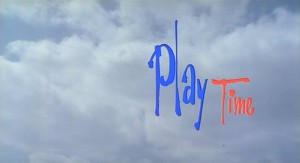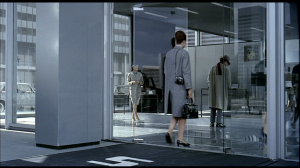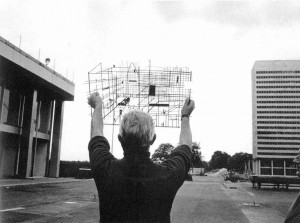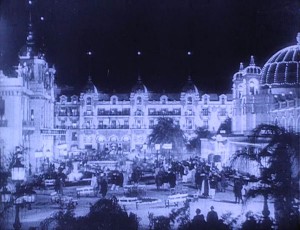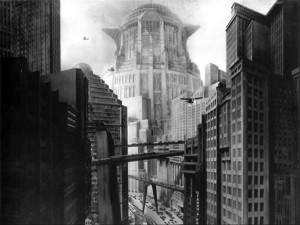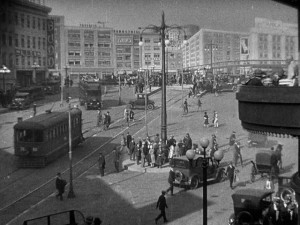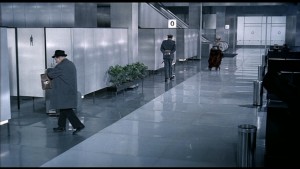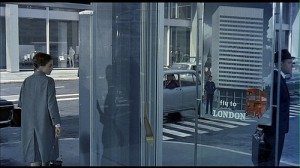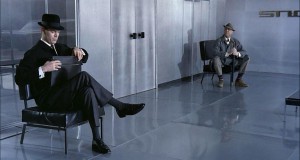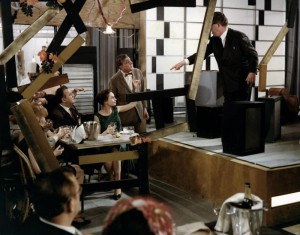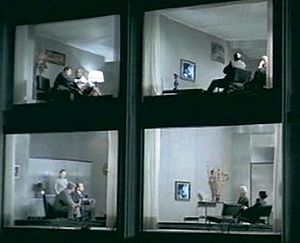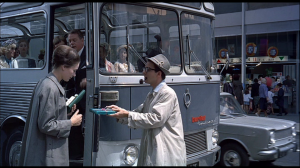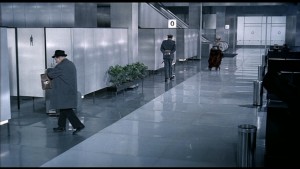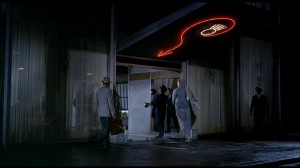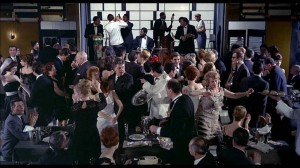Written in 2013 for a 2019 Taschen publication. — J.R.
PlayTime
1. The Title
First of all, what is the title? Like most other critics, I’ve generally known and written it as Playtime, but the final draft of the screenplay in late 1964 called it only Film Tati No. 4. Other early and tentative titles included Récreation (Recess) and La grande ville (The Big City). In 1979, based on the credits sequence and ad logos, film academic Kristin Thompson wrote that the correct title was Play Time. But according to this volume’s editor, “Tati himself referred to it in correspondence always in capitals and always (at least from what I’ve seen) as one word,” i.e. as “PLAYTIME”. And “Macha Makeieff, as the rights holder to the Tati estate, took an official decision a few years back that the official spelling is now to be ‘PlayTime,’ i.e. in one word but with a capital ‘T’.”
Do such distinctions matter? I think they do. American historian Rick Perlstein has called “Play Time “a sentence, not a word, and a command,” adding that one can even “read it as two verbs, a double command.” But what arguably makes “PlayTime” better than either “Playtime” or “Play Time” is its emphasizing the fact that it isn’t either a French or an English title. It’s a non-word belonging to no existing language except for “franglais” — the perception of English through a French sensibility, which also produced such relatively new terms in France during the same period as “parking, “weekend,” and “Drugstore”.
“Parking” got adopted somewhat awkwardly because, like other French nouns, it had to be preceded by an article, making it “un parking”, while “Drugstore” was actually the chic invention of a Paris publicist — an early and relatively compact version of an enclosed shopping mall, such as the one we see in PlayTime just a short distance from the Royal Garden Restaurant. (A London version in Chelsea, immortalized in a Rolling Stones hit, also turns up in Kubrick’s A Clockwork Orange.)
All such terms, dating from the era of PlayTime, were indirect acknowledgments of what might be called the Americanization of the planet, which is plainly part of the film’s subject, even though, practically speaking, the differences between the theory and actual practice of Americanization (and, more generally, modernization) are crucial. Think of the gradual physical collapse of the Royal Garden — its name another example of both franglais and the theory of how things should look and behave rather than the practice of how they actually function.
In many ways, the ambiguity of Tati’s strange title — is “PlayTime” a thing or an activity, a dream or an actual, living possibility? — corresponds to what could be described as the lessons of its architecture. By this I mean not only the city-wide set that Tati had constructed on the outskirts of Paris on which to play out his concepts, but also the architecture and structure of the film itself, and what it does to our sense of how we manage our everyday space as well as our everyday time. Looking straight ahead, which is where the regimented architecture leads and takes us, we make a futile effort to discover or pursue a particular story, until, like Monsieur Hulot, we become lost, or else, like Monsjeur Giffard, the gentleman who spends much of the day looking for him, we wind up smashing into a glass door. But once the glass of another door finally shatters — and once our observation starts to superimpose a playful dance of scanning exploration and improvisation across the rigid space of the buildings — we can spend our time as creative citizens in an interactive community.
2. PlayTime’s origins
Tati once told France-Soir that the film’s first inspiration was a bathroom leak in a sleek but soulless Lisbon hotel where he once stayed, bringing in a steady stream of “experts” that gradually evolved into a crowded party. It’s an anecdote recalling the famous stateroom sequence in the Marx Brothers’ A Night at the Opera, but with a happy moral tacked on at the end. And as pointed out by biographer David Bellos, he was also undoubtedly influenced by his own ambitious and innovative Jour de fête à l’Olympia — a live show he was asked to put on (replacing an indisposed Edith Piaf) in the spring of 1964 that incorporated the screening of a retooled version of his first feature, which tried in diverse ways to break down the usual distinctions made between spectacle and life. In this show, he even employed a group of Monsieur Hulot lookalikes designed to confound audience expectations — a teasing trick that would become central to his design for Playtime.
Certain aspects of PlayTime can clearly be traced back to Tati’s previous features. The notion of vacation-time, and the leisurely pacing that comes with it, was central to both Jour de fete and Mr. Hulot’s Holiday, and a critique of certain alienating aspects of contemporary architecture was already present in Mon oncle. More abstractly and formally, Tati’s penchant for switching from one center of attention to another in Mr. Hulot’s Holiday — having a detail in the background of one shot become a prominent foreground element in the next shot — introduced a notion of simultaneous gags and actions that would become central to the overall conception of PlayTime, above all in the climactic Royal Garden sequence. Similarly, the alternations between boredom and interest, idleness and activity, emptiness and fullness that defined the rhythmic structure of the first Hulot feature provided part of the basis for the way gags would blossom or develop in Tati’s fourth and most ambitious feature, where the notion of a storyline would mainly be limited to the shape of a single day, much as Mr. Hulot’s Holiday was shaped to the overall pattern of a summer holiday season.
Written like a ballet in a detailed, 447-page script that concentrated far more on physical action than on dialogue, Tati worked with his friend Jacques Lagrange, who had helped him in writing his previous two features, a teacher at the École des Beaux Arts who was especially good at providing sketches.
3. Building Tativille
PlayTime’s only real “star” was the gigantic city set Tati had constructed east of Paris, near the Bois de Vincennes and designed by Eugène Roman, after a wasteland there was attacked by bulldozers — requiring over 3500 square yards of timber, 4300 square yards of plastic, 5400 square yards of concrete, and 1300 square yards of glass, built and fitted by a hundred workman working with a dozen technicians over a five-month period. As Tati said to me in an interview, “For my construction, we couldn’t go to the Drugstore and Orly and stop work there, it would’ve been impossible. And I wanted this uniformity: all the chairs, for instance, in the restaurant, in the bank — they’re all the same. [In fact, while we were speaking, in his office, I was sitting in one of them.] The floor’s the same, the paint’s the same. It cost a lot of money, of course, but it’s there — and it’s not more expensive than Sophia Loren.”
Tativille included real streets and traffic lights, some smaller buildings that could be moved around on rails, and even some (though not enough) real advertising to pay for it all, especially after a heavy wind knocked much of the set down, requiring extensive reconstruction, and some rain the next July caused many further delays. Altogether, the shooting took 365 nonconsecutive days.
The best comparisons that spring to mind when it comes to extravagant studio-built cities controlled by single artistic visions — Monte Carlo in Erich von Stroheim’s Foolish Wives, Fritz Lang’s Metropolis, the nameless city in F.W. Murnau’s Sunrise — are all great silent pictures, which seems apt because PlayTime was also shot silently, like Tati’s other features.
An essential part of Tati’s design was the sense of placelessness intentionally conveyed by this enormous set. From the opening sequence, part of Tati’s point is that we no longer can be sure where we are in the modern world, either nationally or architecturally. Is it a hospital waiting room, an office building, or a terminal of some kind? And in what country? It’s roughly akin to a question that Barbara asks Hulot much later — “How do you say ‘Drugstore’ in French?” — and to the posters we see in a travel agency, showing us identical buildings around the globe.
4. Casting PlayTime
Most of the actors chosen were nonprofessionals, and the few professionals and semiprofessionals that Tati employed were sometimes used against the grain of their usual profiles. To consider only the three principal American characters: Barbara, the most prominent of the younger tourists, was played by Barbara Denneke, who wasn’t American at all, but Bavarian — an au-pair who worked for neighbors of his on Rue Voltaire. John Abbey — playing the stiff and mechanical American businessman whom Hulot observes in a waiting-room and whom we also see with his secretary in an office, and who later turns up at the Royal Garden — also took the title role in William Klein’s satirical Mr. Freedom (1969) during the same period. And Billy Kearns, who plays Mr. Schulz — the free-spending customer at the Royal Garden who first seems like a stereotypical Ugly American but winds up as the virtual hero of the film’s second half, the benign benefactor and ringmaster of the impromptu party that develops — was a busy TV character actor who can also be seen in many other notable French features of the period, such as Purple Noon, The Trial, Is Paris Burning?, and Bed and Board. It’s a paradoxical fact about Mr. Schulz that, out of all the film’s characters, he makes the loudest entrance and the most unobtrusive final exit. (After paying for all his guests’ breakfast in a café, he quietly sneaks off and steps into a car in the background of a crowded shot, not waiting to be thanked by anyone.)
5. Shooting PlayTime
In contrast to PlayTime’s 365 nonconsecutive shooting days, Metropolis required a mere 310 days and 60 nights, and the most famous myth about Eric von Stroheim’s mania for detail in his own gargantuan sets and costumes — supposedly requiring his extras on one film to wear monogrammed silk underwear, most likely the invention of a studio publicist, because Stroheim’s profligacy was paradoxically brandished by his studios as one of his selling points — actually finds a faint echo in the more verifiable fact, cited by biographer David Bellos, that Tati once insisted on reshooting a very complicated three-second shot in the Royal Garden sequence for reasons of continuity because the waiter with torn trousers was wearing white rather than striped undershorts.
This suggests a perfectionist temperament, but it’s worth adding that Tati could be relatively lax when it came to satisfying conventional standards of narrative continuity. How, for instance, can Barbara depart on the bus for Orly at the film’s end without any sign of her returning to her hotel or packing her suitcase? How viewers looked at the screen clearly mattered a lot more to Tati than how — or maybe even if — they processed a story, and so did how they listened. It’s however worth noting the astonishing fact that he knew his 447-page script by heart, at least in terms of the contents of every shot.
6. PlayTime’s Soundtrack and Editing
The creation of the film’s six-track stereo sound (including various aural cues to aid or confuse us in following or interpreting the images) as well as the editing required nine months more after the shooting, and when it came to fashioning the particular sound of the waiter’s trousers ripping, Tati’s assistant Marie-France Siegler—who started working for him during the preparations for PlayTime (helping to round up U.S. army officer wives in Paris to play most of the American tourists) and can be briefly seen sitting next to Barbara in the bus bound for Orly — once told me that her boss even tried using his own voice.
As was customary for Tati, slightly different soundtracks were prepared for different countries. Even though the dialogue was intended to be overheard rather than heard, making subtitles unnecessary (even though optional English subtitles are offered today on the American and English DVDs and Blu-Rays), there was somewhat more French heard in the French version, somewhat more English in the version prepared for the U.K., and so on. Tati even engaged the American humorist and Washington Post columnist Art Buchwald (1925-2007) to write the dialogue for the American tourists, based on his own indications of what he wanted to be conveyed at various junctures (and arranging to have a rough cut screened for Buchwald in early 1967), and wound up assigning him a special screen credit for this work.
Two important aspects of the editing of PlayTime are worth noting: (1) This is the first film on which Tati’s daughter, Sophie Tatischeff, worked as an editor, starting off in this case as an assistant. (2) Like the camera movements in PlayTime, which are invisible by design—that is, intended not to be noticed, so that they often follow the same normal paths that the viewer’s gaze would follow — the editing is similarly at the service of the action rather than something to be noticed in its own right. Two especially notable exceptions to this rule — cuts that are meant to produce surprises — are the film’s very first shot after the credits (seen over shots of clouds), which shows a skyscraper accompanied by a “heavenly choir” on the soundtrack, and the climactic overhead image of Paris traffic as a merry-go-round. A far more typical edit is the continuity cut, such as the one between the second and third shots, following the progress of two nuns as they walk down a hallway and then across a waiting room.
7. The “plot” of PlayTime
Any synopsis of PlayTime necessarily betrays its experience because it has no heroes or plot in any normal sense, and the number of narrative details that we can see in many shots makes it impossible take it all in over a single viewing; we have to make choices, making us creative participants in a kind of interactive, life-size board game. Each extra is theoretically and potentially a major character with a separate story and pathway; to follow them all, one essentially has to join them, sharing their disorientation (which makes us all tourists) as well as their eventual enjoyment of one another.
A group of American women tourists arrives at Orly airport. (One should note, incidentally, that PlayTime was made prior to the construction of Charles De Gaulle airport, which would replace Orly for international flights.) Over their day in Paris, these tourists see that the skyscrapers of steel and glass resemble not only one another but the ones back home and the ones they’ve glimpsed in other foreign capitols on their tour. The “old Paris” they’d hoped to see (the Eiffel Tower, Concorde, Sacre-Coeur) appears only fleetingly, as reflections on the glass doors. Periodically crossing their paths is Hulot, who has an appointment in one of these buildings with a M. Giffard; the two briefly meet, then lose sight and track of one another while Hulot and some of the tourists wander through an international gadget fair. There, through a case of mistaken identity, a German executive in charge of an exhibit promoting doors that close (or slam) silently believes that Hulot and not a younger man who resembles him has gone through his desk during his absence, looking for free circulars, and Giffard injures his nose by running into a glass door while chasing after someone else whom he mistakenly believes to be Hulot.
That evening, Hulot and Giffard finally meet up by chance outside the opening of a new restaurant, and Hulot also encounters a couple of old army pals; one briefly invites him home (in another skyscraper — glimpsed by us along with other flats only from outside, through its windows), the other is the doorman at the new restaurant, the Royal Garden, with a glass door of its own that eventually shatters. There Hulot also meets Barbara, one of the younger tourists, as well as the German executive at the gadget exhibition, now in a friendlier mood. Due to the restaurant opening hastily and prematurely, it gradually and accidentally falls to pieces (like its front door) while its diverse clientale, led by a boisterous, free-spending American named Schulz, have a party that lasts all night. After breakfast in a nearby café, Hulot buys Barbara plastic flowers as a farewell gift before she boards her bus, then gets stuck in a line and has to ask a young man who resembles him to deliver it. Opening the parcel on her way to Orly, she sees that the flowers resemble the lampposts flanking the highway.
8. The False Hulots
The young man who delivers Hulot’s plastic flowers to Barbara in the final sequence of PlayTime is only the last in a long line of “false” Hulots spread across the film’s terrain, most of them designed to confound our expectations as well as those of other characters. Three characters resembling Hulot have already turned up very briefly at Orly airport during the opening sequence. More precisely, whether these are separate characters or the same one reappearing twice — or even whether one of them is Hulot/Tati himself (as was indicated in the script) — is ultimately irrelevant. Tati was determined to prove that “the comic effect belongs to everyone” (as he put it to me in an interview), not something to be assigned primarily to any central character.
To make his point even more explicit, Tati brings together two separate Hulot figures — a false Hulot and an irrefutably real Hulot — a little over twelve minutes into the picture, both of them stepping off an old-fashioned Paris bus (which is seen in explicit contrast to the more modern-looking tourist bus that we have just followed into Paris from Orly airport). They come together in a single gag while exiting the bus when their separate umbrellas accidentally become stuck together and the two characters have to dis-entangle them. (Like all the other false Hulots that turn up in the film, this one is visibly younger than Hulot himself, which implicitly becomes Tati’s way of acknowledging his age while generously suggesting that he has to make room for diverse comic “replacements”.) In fact, this umbrella gag is a near-replay of one of the first explicit gags in Mr. Hulot’s Holiday, and significantly one in which Hulot doesn’t figure at all: two men hurrying to board another tourist bus via separate doors both lose their umbrellas when these accidentally become hooked together and fall to the ground.
9. PlayTime’s Original Critical Reception
Back in the 60s and 70s, PlayTime was as a rule more easily accepted and understood by ordinary viewers than it was by many film critics, but sadly enough, not enough ordinary viewers found their way to the film to make it commercially successful. The film’s prestige has grown steadily since 1967-1968, but it was widely misperceived and the source of a certain amount of bewilderment in its own era — especially, it seems, in the U.S. and the U.K., where the film’s failure to follow the conventional rules of movie storytelling mainly yielded boredom, emptiness, and apparent formlessness. This was the impression left by both Penelope Houston in Sight and Sound (who made a point of insisting that neither Tati’s techniques nor his ideas were “ahead of their time”) and Brenda Davies in the Monthly Film Bulletin in London, in 1968. In New York, where the film wouldn’t get a proper launch for another five years (and then only in 35mm, after Tati had lost control over the film), it elicited a rave review in the New York Times from Vincent Canby, calling it Tati’s “most brilliant film,” but terse, alienated dismissals from both Andrew Sarris and Pauline Kael. Speaking for myself, I can’t say I was fully aware of the film’s greatness the first time I saw it, as a tourist in Paris during the summer of 1968, even though it intrigued me enough to go back for a second look. Yet by the time I moved to Paris from Manhattan a year later, I’d come to discover that the film had taught me how to cope creatively and imaginatively with the sensory overload of city life. More simply, it had shown me how I could live in a modern city without feeling crushed, alienated, and overwhelmed by it.
The first critics to appreciate the importance of PlayTime’s innovations in any depth were some of those at Cahiers du Cinéma — especially Jean-André Fieschi and Noël Burch, who had a particularly good feel for the film’s unusual sense of form. When Fieschi and Jean Narboni published an extensive interview with Tati, their first question, marveling at the film’s 447-page script, was how such a complicated construction could ever have been mapped out on paper. (Fieschi even began his subsequent article about the film by randomly quoting shot #269, at the Royal Garden, which alone required fifteen short paragraphs over a couple of pages.) Maintaining that PlayTime was “tout le contraire d’un film littéraire,” “the precise opposite of a literary film” that was written “comme un ballet,” Tati said, “Je connais mon film par coeur, et sur le plateau, je ne regarde plus le script.”
In his own essay, Burch was fascinated by the original way the film either developed or refused to develop particular gags — a process that in some cases entailed not the execution of the gag but the mere suggestion or possibility that it might occur. Burch saw this strange tendency in formal terms, but it’s also relevant to see it as part of Tati’s philosophical position: to view the world as a place where funny things might happen is to conjure up a universe of poetic potentiality — a multitude of virtual realties in place of a single reality. For viewers trained to follow stories that lead to narrative payoffs — morals, solutions, dramatic climaxes — one can easily understand how PlayTime, if viewed less interactively and creatively, might seem empty and uneventful rather than teeming with lively possibilities. Happily, and triumphantly, it is the possibilities and the poetry that remain today, waiting to be rediscovered, played with, and savored.
10. PlayTime’s Lasting Legacy
Many of the greatest filmmakers are individuals who can be said to have reinvented the cinema for their own purposes, and clearly Tati was one of these. This suggests that it’s misleading to see him as part of any logical or organic evolution leading from, say, Buster Keaton to Woody Allen (even though Tati was a fan of both these comics), and more fruitful in many ways to regard him as an artist with a particular view of the world who turned to cinema as the best way of expressing that view. In the case of PlayTime, this might say that this became a philosophical as well as a physical vision, practical as well as metaphysical, which essentially sprang from a conviction that everyone in the world was funny coupled with a regret that not everyone had discovered it yet. Becoming a man with a mission, he saw his job as showing some people how they might better appreciate the world they were living in.
One might even describe Playtime as a nightmarish maze of confusion, obstruction, and frustration that becomes a utopia once the people take over their surroundings — a gradual process, as Tati conceived it, of human, dancelike movements, either spontaneous or accidental, triumphing over regimented, rectangular spaces. This already starts in the film’s second and third shots, when a pair of nuns, guided by the architecture, execute one sharp left turn in unison, then two equally sharp right turns, the cornets in their habits audibly flapping like wings; these are soon followed by the equally sharp turns or glances of at least half a dozen other people we see, including a worker pushing a cart, a trash collector, and a nurse. Then, almost another quarter of an hour will pass before we see Hulot momentarily slipping with the tip of his closed umbrella in an equally sterile waiting room, when the possibility of breaking with this regimentation is most clearly introduced. And much later in the film, once we learn with the help of the bands at the Royal Garden restaurant how to navigate the space with our eyes as if we were dancing, the delighted discovery of the people around us and what’s funny about them becomes a kind of liberation.

